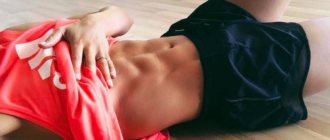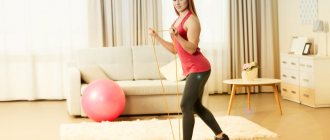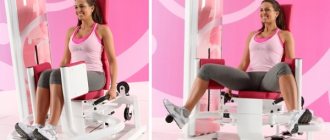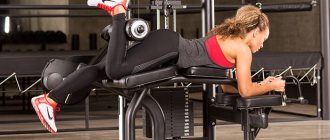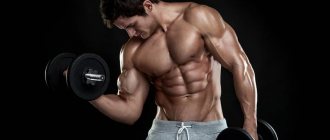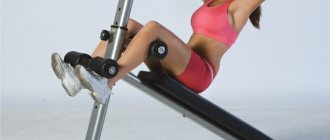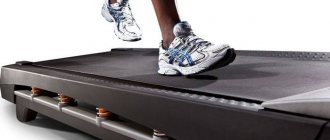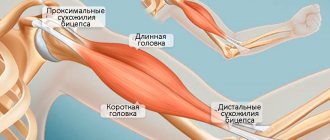If you think about it for a second, generally speaking, unless you live on the beach (or walk around town in a tank top), you don't get the opportunity to show off your muscles very often.
Of course, a well-defined shape still makes itself felt, especially if you wear well-tailored clothes, but when it comes to exposed skin, it's almost exclusively the arms. That's why big, muscular arms get so much attention.
And luckily, increasing your arm strength and size isn't actually that hard.
By working your arms and using this set of arm exercises, you will literally feel how your muscles quickly become stronger and increase in size.
All you need to do (besides the classes themselves) is keep reading!
The most important thing about your hands
Before we move on to the first exercises, let's go over the basics.
The main components of the arm muscles are the forearms, biceps and triceps. Depending on the training program, shoulders are also distinguished, but it is usually better to include them in back and chest workouts (since many heavy movements involve the shoulder muscles).
In other words, we will mainly train the biceps and triceps.
So, for optimal hand training, there are two main methods. If you want to increase size, perform two or three sets of 8-12 reps. If you want to get stronger, do 4-5 reps. For some exercises, strength increases with 1-4 reps, but a one-rep set of biceps curls won't do much for you.
You will also need to consume a lot of protein. No matter what type of training you do in the gym, if you're not getting enough protein to repair muscle tissue, it will be much more difficult to gain size.
Your arm muscles also use protein for energy, so you don't have to think about it in terms of calories. As long as you eat lean protein and stay on a low-calorie diet (this means no fried foods or certain high-calorie ingredients), you can eat as much as you want. When it comes to increasing muscle size, protein recommendations vary from expert to expert. Aim for 2-2.5 grams of protein per kilogram of body weight for maximum muscle gain.
Tips from professional athletes
Professional athletes and trainers working in the field of fitness and bodybuilding recommend not focusing only on arm training, but devoting time to developing the whole body.
At the initial stage, not much time is devoted to the hands, but over time, when classes become more complex and professional, a clearer division into muscle groups begins, and the emphasis moves from basic movements to isolating ones. But it all depends on the goals set and a number of factors, ranging from metabolism to the individual characteristics of the body.
Viktor Borisov, bodybuilder
Russian bodybuilding and fitness champion Viktor Borisov claims that arm training needs to be approached individually. Beginners should not have a separate “arm day,” especially if the goal of the exercise is to gain muscle mass. 2-3 exercises for biceps and triceps will be enough. More professional athletes are advised to proceed from individual characteristics, depending on the development of one or another part of the arms.
Yuri Spasokukotsky, coach
A well-known fitness trainer recommends that beginners exercise adequately and select the load depending on their level of training. You can separate your arms on a separate day or combine biceps and triceps with other parts of the body. In this case, arm exercises are performed at the end of the day, the heavier, basic ones are done first.
Alexander Shchukin, bodybuilder
The owner of a number of bodybuilding titles advises proceeding from personal data. There is no point in training your arms too often; the muscles must have time to recover. But more advanced athletes should increase the complexity of the program to shock the muscles and stimulate their subsequent growth.
Myths regarding arm training
There are many misconceptions about arm training.
When you see someone with arms as big as tree trunks, you might think that they probably train their biceps and triceps every day. However, this is not at all true. In fact, it often happens that in order to grow muscles, you don’t need to train your arms separately at all.
Since evolution put us on the lower limbs, the muscles of the upper body have been much less necessary. That is why the largest muscles of the body are the legs. Over the past eras, the hands have become involved in a much smaller volume compared to other areas of the body. This means that the upper muscles are subject to less stress on a daily basis.
Because these muscles do less hard work, they take a long time to recover. Do a set of arm exercises once, maximum twice a week. By doing more, you reduce valuable rest time and thereby reduce the amount of work you could put into training your chest and back.
Another misconception is that big arms require heavy weights. Yes, heavier weights can help increase size.
However, there is only so much you can move or lift with your arms. There are plenty of people with incredibly sculpted arms who use nothing but their own body weight to train.
So don't worry: even if you work out at home and don't have a ton of money to buy equipment (and luckily your hands don't need that), there is still always a way out.
How to build muscle from scratch
Massive and sculpted arms are the desired result of training for most men. Achieving this goal is possible if a number of conditions are met:
- At the first stage of training, you should not spend too much time on your hands. It will be enough to train them once a week, doing a couple of exercises for biceps and triceps. Some professionals even advise not to do more than one biceps exercise, but to spend more time on basic movements;
- More thorough work on the hands begins after achieving a certain result. Forearm exercises are added, and biceps and triceps exercises become more complex and varied;
- Don’t forget about general training principles. If you don't follow your diet and rest regime, it will be almost impossible to pump up your arms. Muscle growth requires sufficient energy and recovery time.
Doing the same movements all the time is a bad idea. Muscles need to be surprised and given different loads. At the initial stage, any exercise will give you results, and later you need to provide variety.
Attention! An important factor is the gradual progression of the load. Those who work on mass should achieve it by increasing the working weight in the exercises, and if the goal of the exercise is relief, then you can increase the number of repetitions.
Be sure to check out: Exercises and programs for weight loss in the gym Circular training: basic rules of training for girls Effective program for men in the gym: tips for beginners The most effective complexes for working out the hips and buttocks
Never overwork yourself
We've already touched on this aspect, but arm fatigue is a very important issue, so let's delve a little deeper into it.
There is nothing easier than retraining your hands. Too many people want giant biceps, so they do multiple sets of dumbbell curls even if they're having leg day.
This is a big mistake!
From a global perspective, this has a negative impact on weight gain. Since the arm muscles are not designed for long-term intense loads, they have a long recovery time. If you constantly stress your biceps and triceps during training, you will disrupt the healing process.
So, if your arms are constantly working overtime and you still don't see any progress, it's most likely due to overwork.
Top to bottom, left:
Triceps, anconeus, extensor carpi ulnaris, extensor carpi radialis longus
Top to bottom, right:
Deltoid muscle, biceps muscle, brachialis muscle, brachioradialis muscle.
No. 1. No load progression
If there is no progression of load in your training, there can be no talk of any muscle growth (not only arm muscles, i.e. biceps and triceps), but also all other muscle groups!!! IF there is no PROGRESSION OF LOAD, then there is NO POINT for muscles to GROW! FINALLY UNDERSTAND THIS!!!
Therefore, read the main article (a must READ! Don’t be lazy, YOUR MUSCLE GROWTH DEPENDS ON THIS!!!!!!): “The progression of the load is everything from A to Z.”
Heads of biceps and triceps
The best way to strengthen your arms is to understand how the heads of the muscles work.
This way you will understand what you are missing and what basic arm exercises you need to do to train your muscles. Your biceps consists of two heads. Namely - from external and internal. The inner head is responsible for the height of the biceps, the outer head for the width.
The triceps have three heads. The lateral one runs along the entire length of the back of the shoulder. The long head of the triceps curls up and meets the shoulder. The third head is called the middle one. It wraps towards the biceps and is located directly under the long one.
All three of these heads together form the horseshoe shape that can be seen on the triceps.
Recommendations for training
Due to the small size of muscles and the possibility of cheating in exercises, there are the following training recommendations:
We recommend reading: Compatibility of steroids and alcohol
- Work one arm muscle group per workout. For example, back + biceps or chest + triceps (the principle of training synergistic muscles). This optimizes the workflow and allows you to combine heavy basic movements with special ones. Experienced athletes can specialize in arms, training them completely in one day. This approach is not recommended for beginners.
- If you do biceps after back or triceps after chest, a couple of exercises will be enough for them. If you do 4-5, this will lead to overtraining and your arms will not grow. The same thing can happen if your split is built like this: back + triceps, chest + biceps. In this case, the biceps will work 2 times a week, and the triceps will work 3 times a week (another time on shoulder day during presses). It's too much.
- Work in a multi-rep style - 10-15 repetitions. This reduces the risk of injury and increases blood flow into the muscles. Small muscles respond better to such a load, since they were not originally designed to lift large weights.
- Perform exercises with strict technique. Leave cheating to professional athletes. It will be much more effective to lift a 25 kg barbell absolutely cleanly on your biceps than to throw 35 kg with your body and shoulders.
- Don’t get carried away with pumping, supersets and drop sets. Using the example above, again, it will be more effective to lift a 25 kg barbell for biceps for 12 reps than to do 15 kg for 20 reps or 15-10-5 kg for 10 reps (drop set). These techniques are best used when you reach a certain plateau in weight gain, already having experience in strength training and decent working weights.
Working out the heads
Typically, your grip and position will influence which head you work.
Let's start with the biceps.
If you hold the bar close to your body or even move it across your body (imagine bending your right arm toward the left side of your body), you are working the inner head. If you want to engage the outside head, the grip needs to be a little looser (instead of holding the bar directly to your body, make a longer bend, as if you were trying to reach your shoulder).
To do the most effective exercises for the lateral head of the triceps, you need to keep your arms close to your sides. Examples of such exercises are push-ups or French presses. The long head is used when the arm is placed behind the head (such as a bodyweight French press, which we'll get to later).
The middle head is used when placing the arms along the body and with a reverse grip.
Tips for correct and more effective exercise technique
Now let's figure out how to pump up your arms in the gym, using special techniques in each movement with an emphasis on the relief and mass of the biceps and triceps muscles. If we pump any muscle group with the wrong technique, the effectiveness of the exercise decreases and the risk of injury increases. And in some cases, a different muscle group and not the target muscle group is pumped. For example, in biceps curls, the back can be involved if the technique is incorrect, especially when cheating.
There must be a mental connection between brain and muscle, that is, you must feel the work of the target group.
Seated dumbbell curls and French bench press with dumbbells
Start with 4 sets of dumbbell curls. Perform each repetition at a slow pace, with an emphasis on the negative phase. During the concentric phase of the movement, rotate the hand so that the little finger is on top at the end point.
For the last set, halve the weight. While you perform eight repetitions with one arm, keep the other in a contracted position. Then change hands and repeat. Immediately do 7 reps with one arm while keeping the other contracted, then switch arms and do 7 more. Continue shortening the reps until there is only one rep left. Do it with each hand to complete the exercise.
Follow the same plan for the French bench press. Hold the dumbbell at the bottom of the amplitude, maintaining tension in the triceps.
Bicep curls on a Scott bench and seated French press with a dumbbell
When performing curls on a Scott bench, do not lift the barbell all the way to avoid losing tension in the muscle. Do not delay the movement so that the biceps constantly contracts. In extensions from behind the head, the elbows look up and do not move apart. Lower the dumbbell to the very bottom, properly stretching the triceps. As with curls, don't stop at the top. Move constantly, keeping tension in your biceps and triceps all the time.
For the final set, use a double drop set for both exercises. In it you go to failure. You won't be able to do as many reps as you did when you started, but get at least 6.
Bicep curls on an incline bench and overhead arm extensions on a block with a rope handle
Lower your hands to the very bottom for a good stretch of the biceps. At the bottom, squeeze your triceps to give your biceps a maximum stretch. After completing the twelfth repetition of the fourth set, lower your arms again and hold them for 30 seconds to stretch. Lose the weight by 4-5 kg, perform the exercise to failure, and lower the dumbbells again for a 30-second stretch. Lose the weight again by 4-5 kg, perform to failure and repeat the stretch.
In extensions, pull the rope as far back as possible to fully stretch the triceps. After the twelfth repetition of the fourth set, repeat the drop sets exactly as in the previous exercise.
If you were able to complete 10 or more reps before failure on any of your finishing sets, add more weight next time.
Barbell curls and arm extensions on an overhead block with a rope handle
Perform the first seven reps standing, lifting the barbell from your hips to a right angle at the elbow, then immediately sit down for the next seven reps. In a sitting position, you will not be able to lower the bar below your hips. Once completed, stand back up and do the remaining seven full range of motion, moving the barbell from your chest to your hips, bringing the total number of reps to 21.
Here all repetitions are performed standing. The first seven repetitions start from the waist and reach the hips. The next seven starts from the shoulders and finishes at waist level. The final seven is a full range of motion, from the shoulders to the hips. Total 21 repetitions. Try to keep the ends of the rope as far apart as possible.
Alternating hammer curls and extensions on a block with one hand
Bend your arms alternately for a more powerful movement. When doing extensions, additionally contract your triceps, and at the bottom point, tense your entire arm for half a second.
Lower pulley biceps curl with cable handle and pulley extension with straight handle
There is no better way to finish this arm workout than by wearing BFR bands. You will achieve a great pump and pump blood and nutrients into your arms.
Place the BFR bands high on your biceps. Tighten them 6-7 points on a scale of ten. Maintain them for all 5 sets. When performing exercises, rest 45 seconds between sets to achieve an extreme pump.
We recommend doing this workout once every two weeks. There's just too much volume and it's just too damn hard to do every week.
The best exercises for arms!
For biceps
The great thing about arm exercises is that good biceps movements also work the triceps (and good triceps movements also work the biceps).
The key here is to return to the starting position slowly and in a controlled manner. If you're doing a standard curl, don't just throw weights. Count to at least two as you move down. If you only have access to light weights (or resistance bands), increase the count to four.
This simply increases the time under tension and the work done by the muscle, which increases the incidence of microtrauma and aids in volume growth.
Biceps curl while lying on an incline bench
The best arm exercises are movements that stretch the muscles more.
A longer stretch puts more tension on the muscle, which results in more microtrauma and ultimately larger, stronger muscles. That's why the incline curl tops this list. Few isolated arm strength exercises provide as much of a stretch as this one.
Plus, this is a great move for the triceps too.
In order to perform it, you will need an incline bench. Hold a dumbbell in each hand and let your arms hang naturally at your sides. Slowly bend your arm with the weight, hold it at the top point, then slowly lower it. This movement is great for targeting the triceps, so be sure to keep the movement fluid. From the starting position, stretch your biceps even further, tense your arm and move it even further back.
This will create additional tension on the triceps.
Squeeze your triceps and lift your arm up for the next rep.
Squeezing your triceps at the end of the movement isn't necessary, as it's just an added movement built into the regular incline curl, but it will pay off if you do it.
Scott Bench Curls
You already know what a regular bicep curl looks like.
Plus, bending on an inclined surface stretches the arms more, which causes more microtrauma. Instead of focusing on the regular fold, we'll look at the Scott Bench fold. The benefit of this is that you can vary the movement to target the inner or outer head of the muscle. Few exercises for the arm muscles provide such an opportunity for direct impact. For the same reason, it is better to use dumbbells for curls on the Scott bench.
Sit behind Scott's bench.
If you don't have access to one, you can simply use an incline bench: stand behind it and use the incline as an elbow rest. By focusing on each arm separately, you can perform a much more closed curl (or cross-body curl) to engage the inner head. If you want, you can do one approach on the inside, the second on the outside.
And that's the beauty of the Scott Bench fold.
The best triceps exercises
French press
As we said earlier, we’ll get to this exercise for the arm muscles, and now we’ve finally got there.
For this arm-building exercise, grab a short barbell (or dumbbells if you prefer, but this will require extra effort to balance, so if you have weak shoulders, it's best to start with a barbell). Lie down on a bench and hold a loaded barbell overhead. It is better that the elbows are slightly bent, the grip should be narrow.
Lower your hands until they are near your hairline. This way all the tension will be concentrated in the triceps. Slowly lift the barbell to the starting position (this engages the biceps) and hold it with slightly bent arms. Thanks to this, you will engage your biceps and better work your arm muscles.
Dips
You don't need weights to work your triceps; there are other arm exercises in the gym.
Remember earlier when we said that one of the biggest misconceptions is that you need heavy weights to get big strong arms?
Dips prove that this is not true (of course, you can challenge yourself and use leg weights or a weighted vest). It is best to do push-ups so that you are completely off the ground. Make sure your body remains perfectly straight as you move down, with your elbows bent at a 90-degree angle, pause to stretch the muscles as much as possible, and return to the starting position. If you're doing the exercise at home and don't have access to full parallel bars, use a coffee table while extending your legs.
This way you're not putting your full body weight on your arms, but it's still a great exercise.
Triceps extensions in the block
This is an arm exercise in the gym. For this exercise you will need a cable machine. Stand with your back to the machine and grab the cable overhead using a straight bar. It should be at about chest level, so your arms are bent at a 90-degree angle. Pull the cable. Since your elbows are pressed to your body, you will be working primarily on the lateral and medial heads. Lower the weight slowly to target the inner head of the biceps.
No. 3. Lack of mental brain-muscle connection
By the way, reason No. 2 (exercise technique) is very closely intertwined with this reason. Why? => Yes, because you have the correct (ideal) technique for performing this or that exercise, it will be much easier for your brain to contract the muscles you need (in our case, these are biceps and triceps). This is a very long topic, in short, remember:
The better your technique is developed (+ mental connection between BRAIN and MUSCLE), the faster you will grow (in our case, increase the mass of your arm muscles).
It also happens that a person has good technique for performing an exercise, but there is no mental connection between the brain and muscle, therefore, his muscles will not contract as effectively as they could. But if you have the right technique (ideal) + a developed mental brain-muscle connection, then your muscles (your arms) will contract as efficiently as possible! As efficient as possible. Draw your own conclusions. I also recommend the article: “MENTAL BRAIN-MUSCLE CONNECTION.”


